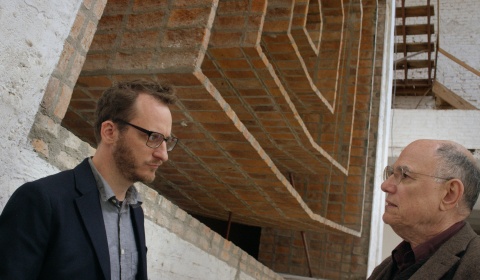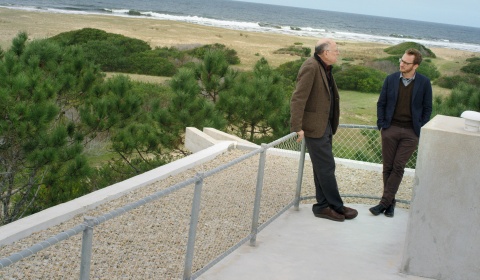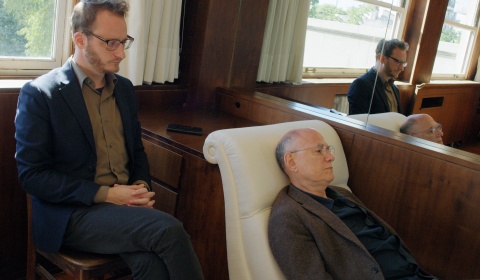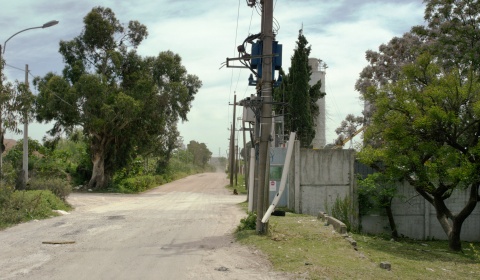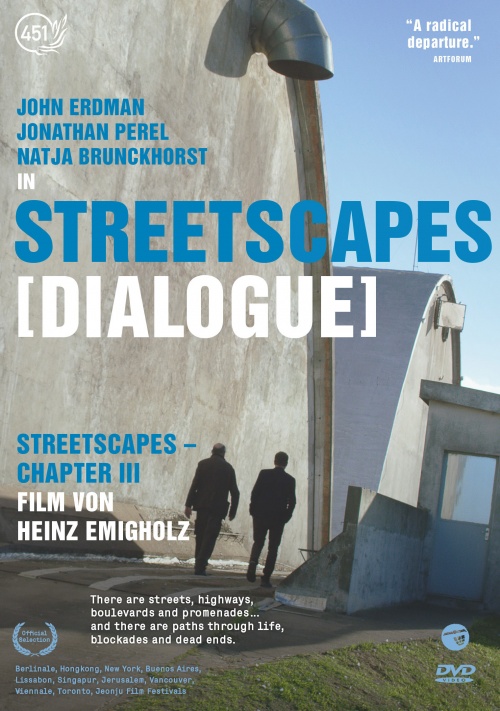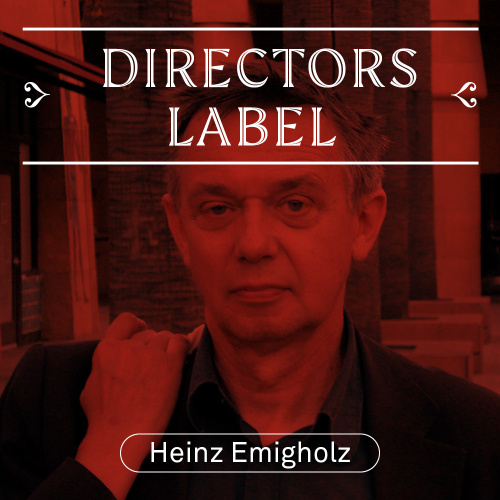
Streetscapes [Dialogue]
GER 2017, 132 min
There are streets, paths, motorways, alleys, boulevards and promenades. And there are life paths, intersections and dead ends.
Synopsis
There are streets, paths, motorways, alleys, boulevards and promenades. And there are life paths, intersections and dead ends. Two men sit on the shady raised platform of a brick building somewhere in Montevideo. They are submerged in a conversational marathon that never ceases throughout the entire film. The younger of the two is an analyst; the older man his analysand. Their nationalities are unclear; they speak a simple, internationally understandable English. They talk about a childhood among the ruins and the traumatised people of Germany shortly after the Second World War, about fleeing, about an obsessive interest in architecture and about manic writing. And they speak about work with the film camera, which is a technical instrument for the young analyst, but a lifeline for the old film director. The starting point of the six-day marathon is the psychological and physical block that prevents the director from starting a last great film, the Streetscapes saga. The conversation, which in a slow process dissolves the director’s block, takes place in changing places in extreme architectures. The camera, which portrays them both and sets them in relation to the architecture, becomes a third partner. The camera repeatedly disengages from where they are and explores the surrounding streets and neighbourhoods before returning to the two protagonists. The shell constructions of the Uruguayan builder Eliado Dieste where they sojourn resemble gigantic braincases and thus provide a framework for the site and the theme of the project that emerges in the course of their talk: trauma and architecture.
STREETSCAPES [Dialogue] is the first part of Heinz Emigholz’ STREETSCAPES-series, which also includes 2+2=22 [The Alphabet], BICKELS [Socialism] and DIESTE [Uruguay].
Streaming-Info
Rent or buy the movie on our Vimeo channel. For other providers, see “Watch Movie”.
Language: English, Subtitles: German, French, Spanish, Chinese
Film kaufen
VOD
451-Vimeo
DVD
451-Alive Shop
amazon
Press reviews
A film based on a therapeutic scenario may sound dry, but in effect STREETSCAPES [DIALOGUE] is a sensory bombardment, and very funny to boot, bringing to the surface the, undercurrent of deadpan humor that runs through much of Emigholz’s work. Against an unceasing stream of erudite talk, almost every frame contains an unexpected configuration of human and architectural form. – Dennis Lim, ARTFORUM/2018
Awards and Festivals
- Berlinale Forum, 2017
- Hong Kong International Film Festival, 2017
- Art of the Real, Film Society of Lincoln Center NY, 2017
- BAFICI Buenos Aires Festival Internacional de Cine Independiente, 2017
- IndieLisboa International Film Festival, 2017
- Singapore International Film Festival, 2017
- Jerusalem International Film Festival, 2017
- 2. Hamburger Film-In, 2017
- Underdox Filmfestival für Dokument und Experiment München, 2017
- Vancouver International Film Festival, 2017
- Milano Design Film Festival, 2017
- Viennale – Vienna International Film Festival, 2017
- Heinz Emigholz Retrospektive im Stadtkino Basel, 2017
- Human Rights Festival Zagreb, 2017
- RENCONTRES INTERNATIONALES PARIS/BERLIN, Centre Pompidou Paris, 2018
- Images Festival Toronto, 2018
- Jeonju International Film Festival, 2018
- Instituto Moreira Salles (IMS), Rio de Janeiro, São Paulo 2019
- Museo de Arte Moderno de Buenos Aires, 2019
Additional Texts
From the exposé to the project Streetscapes
by Heinz Emigholz
In my films on the oeuvres of certain architects or on individual buildings, the landscapes we found them in and the streets, intersections, and cities in which they were built increasingly played a dominant role. We filmed on famous streets in well-known cities, on Route 66 in Tulsa, Oklahoma, on Wilshire Boulevard in Los Angeles, on the Graben in Vienna, on Monroe Drive in Chicago, on the Via Appia south of Rome, on the Boulevard de l’ALN in Algiers, on the Place d’Iéna in Paris, on Rustaveli Avenue in Tbilisi and on many other streets without naming them. And we filmed on the side streets and dead ends of deserted backwaters like Boise City, Oklahoma and in megacities like Mexico City, without naming the streets. The buildings were important to us as condensations of reality, but our gazes always wandered to the ends of the streets or continued to intersections, ensembles of plants or landscapes that weren’t directly relevant to the theme. Sprawling and perforce anonymous design ensembles increasingly became my theme. I can no longer describe or depict the whole of our reality through reduction to an authorial architecture. Instead, it is becoming ever more necessary to describe an anonymous situation, all of whose details are furnished with the insignia of an authorship, but whose multipartite will to shape can be called almost tragic, considering the whole and its contexts. Amid this ensemble, the individual designer begins to feel like Sisyphus in the myth. For our eyes, at any given time and in any given weather, the texture of the real appears as a continuum. The camera can shape this continuum in the individual shot with the intent to illuminate or to cloud over; it cannot subdivide it. The ‘off-screen’ of intentions and meanings will find its way into the field of vision, again and again. Not until editing does the time machine – film – leap into the next possible continuum, which keeps its surfaces just as closed as the previous picture. But the omissions that every editing or postproduction technical intervention produces mislead us into projecting a narration. Every edit between two shots and every picture-internal, animation-technical intervention is the core of a story that either continues plausibly or moves into improbability. But the connection that this pictorial language enters into with the language spoken in the film is a balance that must be found anew, an experiment, in each film. The efforts of various companies to make all street views ‘democratically’ accessible by repeated filming and streaming of the earth’s street networks – optionally mixed with historical photos, i.e., adding a certain ‘deep time’ – suffer, like many pictorial worlds in the Internet, from the fact that they are not designed. There is no shaping selection of a consciousness behind the camera (and there can be none in this ‘encyclopaedic’ project). Instead, the task of registering everything is delegated to a machine that records everything dispassionately and senselessly. And it carries out its task summarily in a rigid production framework: long shot, dolly shot, 360º pan and zoom options that lose themselves in pixels. Our filming trips are at the other end of the spectrum of filmic possibilities: their result should be thoroughly designed, deliberate pictures that reflect a consciousness and the presence of a human brain behind the camera. The justification for our project lies in this poetically concentrated looking, and not in any kind of ‘encyclopaedic’ ambition.
Statement of Co-Writer Zohar Rubinstein
Streetscapes [Dialogue] is a film manifestation of a project held in Germany and mainly in Israel for three intensive long marathons of dialogues between the two of the film writers, Heinz Emigholz and I. We met to talk, attempting to remove an obstruction of silence of the former, muting his artistic journey and darkening his life (then) into a downfallen alley. We meet to work. Not in a therapeutic encounter though the latter is a psychologist and an expert in trauma, but as two persons willing to undergo a hard journey for the designated end.
Streetscapes [Dialogue] is about giving and receiving a testimony of trauma. In fact, it all started when I invited Emigholz to my lecture I gave at the conference held at the Freie Universität Berlin on testimony. My topic was about the silence of the traumatic witnesses which is their testimony. We talked after that and Emigholz shared with me his situation. I thought we should meet for a marathon and talk about the block and his origins. I felt then that Heinz needed to give a testimony and I should be his witness of it. His silence must be heard first to turn his mutism into a path. He willingly accepted the idea. We started few months later.
My role there and then was not as psychotherapist but as a person who becomes a living witness for a testimony well buried beneath the memories. I insisted it will not have resembled a therapy. The long and intensive dialogues turned into a long continuous dialogue of a Buberian nature. It was a person to person talk as Buber conceived it, where the “space in between” (“das Zwischenmenschliche”) becomes the medium through which meaningful mutuality, care and containment, and most important attentive listening, became the transformative factor for growth. We could both witness how the post traumatic testimony gradually became a post traumatic growth. The idea of making a film out of those dialogues was the sign heralding the removal of the block allowing creativity to start flowing.
Our acquaintance, it is important to add, has not started in Berlin conference but in our shared interest in architecture (Emigholz in the cinematographic of architecture and I in the relationship between trauma and architecture). Heinz's reputation of his long list of both documentary and feature films on architecture is a fact a testimony of itself. In the Streetscapes [Dialogue] Emigholz took architecture to portray the “space in between” and formed it into the third protagonist of the dialogue. This aspect which was not present in the marathons encounters was another sign for us for the return of the spoken.
Watch Movie
VOD
451-Vimeo
DVD
451-Alive Shop
amazon
Credits
Director
Heinz Emigholz
Screenplay
Heinz Emigholz, Zohar Rubinstein
With
John Erdman, Jonathan Perel, Natja Brunckhorst
Director of Photography and Editor
Heinz Emigholz, Till Beckmann
Camera Assistant
Manja Ebert, Nacho Rodríguez
Original Sound
Rafael Álvarez, Rainer Gerlach, Markus Ruff, Takis Sariannidis
Sound Design
Christian Obermaier, Jochen Jezussek
Sound Mixer
Jochen Jezussek
Postproduction
Till Beckmann
Productionservice Uruguay
Micaela Solé, Cordón Films
Production Management
Patricia Olveira, Markus Ruff
Production Assistant
Eva Flügel, Viviana Kammel, Mauricio Rodríguez
Producers
Frieder Schlaich, Irene von Alberti
Produced by
Filmgalerie 451
Founded by
Die Beauftrage der Bundesregierung für Kultur und Medien – BKM, Medienboard Berlin-Brandenburg
DVD-Details
Extras
2 film talks with Heinz Emigholz, Stefanie Schulte Strathaus and Alexis Waltz (Audio, 122 min, only German), Chapter Navigation, Presskit, Trailer
Language
English
Subtitles
German, French, Spanish, Chinese, Hebrew
Country Code
Code-free
System
PAL / Color
Length
132 min + 122 min Extras
Aspect Ratio
16:9
Sound Format
DD 5.1 + 2.0
Set Content
Softbox (Set Content: 1)
Release Date
30.11.2018
Rating
Info-Programm gemäß §14 JuSchG
Distribution Details
Screening Format
DCP (2K, 4K, 25 fps, 5.1)
Blu-ray Disc
Aspect Ratio
Digital, 1.77 (1920 x 1080p)
Language
English
Promotion Material
Trailer, A1-Poster
License Area
Worldwide
Rating
Info-Programm gemäß §14 JuSchG


